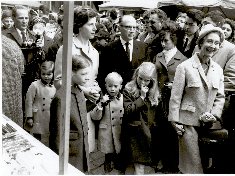 1963 - the young princes Henri, Marie-Astrid, Margaretha and Jean in the Emmausmarkt
1963 - the young princes Henri, Marie-Astrid, Margaretha and Jean in the Emmausmarkt
 1963 - the young princes Henri, Marie-Astrid, Margaretha and Jean in the Emmausmarkt
On Easter Monday,a little fair takes place, mainly for potteries, in front of the church Saint Michel, and it attracts many people especially children.
1963 - the young princes Henri, Marie-Astrid, Margaretha and Jean in the Emmausmarkt
On Easter Monday,a little fair takes place, mainly for potteries, in front of the church Saint Michel, and it attracts many people especially children.
| On Easter Monday morning throughout the old town of Luxembourg, one hears the song of nightingales and cuckoos. The townpeople are celebrating Émaishen, the diminuative for Emmaus, the festival of whistles known in Luxembourg as "Peckvillercher". Since dawn, whistles makers from all over Europe have installed stands and booths at the Fish market to sell their Peckvillercher to children. Even the children of the Grand Ducal family will buy Peckvillercher by the end of the morning. Studying this fair is interesting as a good example of the difficult interpretation of a folk tradition. |
|||||||||
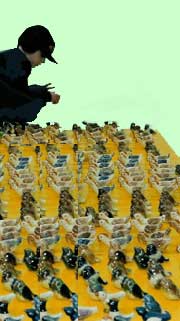 |
There is a temptation to interpret this old folk tradition using honored phrases, that it continues old rituals in which whistle songs were incantations to assure and celebrate the renewal of spring. The actual history may be more prosaic On Easter Monday took place the feast of the guild of potters in the Saint Michel church, maybe because of a passage of the Bible: " Je descendis chez le potier, et voici qu’il travaillait au tour. Mais le vase qu’il fabriquait fut manqué, comme cela arrive à l’argile dans la main du potier. Il recommença et fit un autre vase, ainsi qu’il paraissait bon au potier " (Jr 18,4-5)This verse is associated with the Resurrection and is present in old liturgies of this day. A pottery market was following the mass. We are still far from the present Eimaischen feast. No quotation of this festival in the many sources about the old festivals in Luxembourg. Even the pottery market doesn't appear in the old statistics about markets.
This market of Emmaüs is quoted for the first time in a letter of April 3, 1827.
The police inspector Jhemp Müllendorf proposed in this letter to the town council to move this fair towards the fish market. It was made on April 16, 1827. Le lundi de Pâques se tient une petite foire, principalement en poterie, en face de l'église Saint Michel, et elle attire un grand rassemblement de monde, surtout d'enfants. (...) ***
|
||||||||
| One can suppose that these children were attracted by the toys sold or offered to the customers'children among which the whistles held a significant place as everywhere else in Europe. The market of Emmaüs lost little by little its character of potters market and became a market of bric-à-brac. But before 1914, much of the children still came there to buy clay toys, most of them produced in the nearby village of Nospelt.
We are far from the agrarian rites often evoked for this festival. Of course, the song of the whistles marks also the end of the winter especially the globular whistles which sound evokes the cuckoo, symbol of the return of spring. But it should be noted that in the history of Eimaischen, this symbolic system holds a weak place! Moreover, most of the old whistles were not "cuckoos" (globular whistles) but "nightingales" (water whistles). |
|||||||||
| From this time, only a few whistles of the former production in Luxembourg remain. A tubular whistle dated between the 16th and mid 18th century similar to the numerous mouth pieces inserted in the water whistles was found in Luxembourg unfortunetly, the lack of the whistle body make impossible to know its general shape. Another similar whistle found in the Boursheid castle is dated between the 14th and the 16th centuries. Except for these water whistles, a fragment of a ridder is close in its typology to the ridder shape whistles made at this time in the east of France and in Germany. |
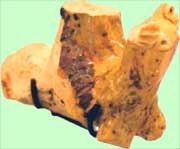 Fragment of ridder (whistle?) late 15th, early 16th C. Prov Fonds anciens Musée National d'Histoire et d'Art Luxembourg |
||||||||
 Mouth piece of a water whistle ca 1500-1750 Musée National d'Histoire et d'Art Luxembourg |
|||||||||
| Even if there are only few whistles, they attest the antiquity of the whistle production in Luxembourg. Located in the center of a region where this medieval production was so important (Raeren, Flanders, Metz, the Rhine Valley...), a lack of whistles would not have been normal.
|
|||||||||
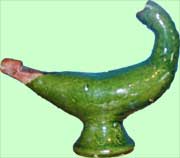 Sifflet à eau 1850-1914 Terre cuite vernissée de Nospelt Musée National d'Histoire et d'Art Luxembourg |
The modern production prior to 1914 is hardly better known. A very special water whistle is shown in the Musée National d'Histoire et d'Art of Luxembourg. Its originality comes from its opened neck instead of the bird head when a filling hole exists on top of the whistle (left)
It represents the former production. The pottery industry in Nospelt stopped in 1914 when Nicolas Schneider (1868-1941) lit for the last time his kiln. |
||||||||
| After a break during the World War 1, Luxembourg carried on the Émaishen festival but it was declining year after year. The whistles sold there had been made in the nearby German region of Eiffel since a long time. It was in 1937 when, due to an initiative of some inhabitants of the old town, a comitee, the 'comité Alstad', was created to revive this old tradition. A Luxembourg text says that in 1938 have been sold the first Peckvillercher from Luxembourg since 20 years.
The pionneer of these "new" potters was Jean Peters of Reckental who moulded many models with the red clay from Nospelt. Those moulded whistles show the German or Belgium influence of the pottery centers of Drachenfelds, Heinbach or Raeren.
One of his bird whistle became the symbol for a 'peckvillchen' and is still produced nowadays.
|
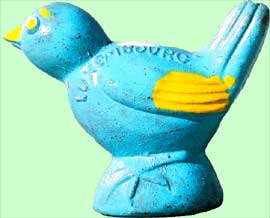 |
||||||||
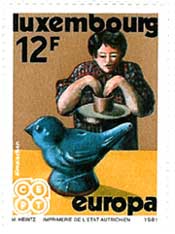   |
|||||||||
| Nowadays, this market still takes place in the "marché aux poissons" (fish market) but it overflew in the nearby streets to accomodate many other craftsmen. Émaishen is now a very important festival in the Luxembourg town. Tourists et booths swarmed over the streets. The "festival of whistles" lasts for the whole day, still animated by its dynamic comitee.
For other information about Eimaischen: http://www.comitealstad.lu/ the website of the comiteeSince 1957, this festival has been also celebrated in Nospelt. Any whistle sold there has a stamp "Nospelt" and the current year. Each year new shapes and new glazes are created. The Nospelt potters also make an "item of the year". It is obvious that in 2000, this item was a very big bird whistle to write an optimistic first page of the Luxembourg whistle story for the third millenium. |
|||||||||
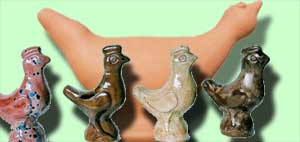 |
foreground: Peckvillercher from Nospelt 1984,1985,1986,2001 background: Item of the year Nospelt 2000 Private Col. |
||||||||